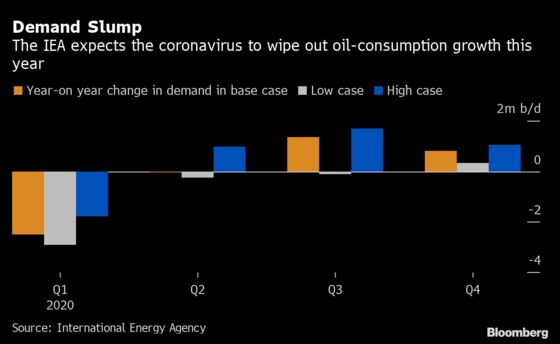Oil Demand to Drop This Year for First Time Since 2009, IEA Says
Oil Demand to Drop This Year for First Time Since 2009, IEA Says
(Bloomberg) -- Global oil demand will decline this year for the first time since the 2009 financial crisis as the coronavirus slams the global economy.
All of the annual growth the International Energy Agency had anticipated last month -- just over 800,000 barrels a day -- has been wiped out and demand is now expected to contract by 90,000 barrels a day. In a rare move, the agency included a more pessimistic scenario in which the demand loss would be many times more severe.
“In the past few weeks, coronavirus has gone from being a Chinese health crisis to a global health emergency,” said the Paris-based IEA, which advises most major economies. “Containment measures have resulted in drastic reductions in international and domestic transportation around the world.”

The report reaffirms a bleak outlook for the global oil market. Prices crashed more than 30% early on Monday to almost $30 a barrel in London after the Organization of Petroleum Exporting Countries and its partners abandoned attempts to stabilize oil supplies, choosing instead to compete in an international price war.
The loss in annual demand now projected for 2020 still hinges on fuel use rebounding “close to normal levels” in the second half of the year, the agency said.
If the IEA’s more pessimistic scenario is realized, world demand will tumble by 730,000 barrels a day in 2020. That option assumes that “countries already affected by the virus recover more slowly, while the epidemic spreads further in Europe, Asia and beyond.” In a more optimistic scenario where the “situation comes swiftly under control in China,” world fuel use may yet grow by 480,000 barrels a day this year.
The hit to demand has already been profound, with a worldwide drop of about 2.5 million barrels a day during the first quarter, the IEA said. Consumption in China, which last year accounted for 80% of global demand growth, plunged by 3.6 million barrels a day last month.
As a result, inventories around the world may be poised to balloon. Even though it has been an implementing a new round of production cutbacks this year, OPEC has pumped about 3.6 million barrels more than was actually needed during the first quarter, the IEA’s data showed.
Following the dramatic split between OPEC leader Saudi Arabia and key partner Russia last week, that oversupply could swell even further. OPEC nations hold about 4.5 million barrels a day of spare production capacity, according to the IEA report, much of which could be reactivated and pushed onto world markets as the price war escalates.
All the while, countries outside of OPEC like the U.S., Norway and Guyana continue to add new supplies. The IEA left unchanged its estimates for non-OPEC production, which stands to grow this year by 2.1 million barrels a day.
To contact the reporter on this story: Grant Smith in London at gsmith52@bloomberg.net
To contact the editors responsible for this story: James Herron at jherron9@bloomberg.net, Amanda Jordan
©2020 Bloomberg L.P.